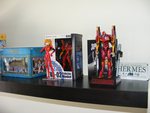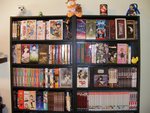Shelf Life
Teatrino for Two
by Erin Finnegan,

Dragon Ball Z Kai part 1
Rental Shelf
Gunslinger Girl - Il Teatrino BD
Perishable
None this week.
Stream Worthy
Giant Killing ep. 1-10
July 24th is the fifth anniversary of my podcast, The Ninja Consultant Show. I neglected the podcast for most of 2009 because Noah and I were busy planning our wedding, which was held on June 20th, 2009, in zero gravity. To celebrate my very first wedding anniversary, I'm taking June 21st off from Shelf Life. We're seeing a Broadway show (Fela) and having a nice dinner at a famous restaurant we've never been to (Peter Luger's).
Dragon Ball Z Kai marked the 20th anniversary of Dragon Ball Z airing in Japan.
 My name is Erin Finnegan and I approve of this Dragon Ball Z re-release. I wasn't paying attention the nerd news and somehow thought Kai was a prequel. I was upset to find out it's a re-cut of the original, because I've been watching lots and lots of Dragon Ball Z lately. I was pleasantly surprised to find Kai much more watchable than the straight-up Dragon Boxes.
My name is Erin Finnegan and I approve of this Dragon Ball Z re-release. I wasn't paying attention the nerd news and somehow thought Kai was a prequel. I was upset to find out it's a re-cut of the original, because I've been watching lots and lots of Dragon Ball Z lately. I was pleasantly surprised to find Kai much more watchable than the straight-up Dragon Boxes. Kai (which means "revision") brilliantly cuts out the filler, making the series about one-third the length of the original. I wish someone would release Naruto Kai, Bleach Kai, or even One Piece Kai. It would save me a lot of time (and pain). Granted, even with the filler cut out, this is still an awful lot of DBZ to watch.
I hate the new opening and closing sequences. The characters all have an extra highlight layer, which makes them look weird compared to the more duo-toned original. Granted, no song could ever live up to "Cha-La Head-Cha-La" but the new songs are totally lame. The end credits have lyrics like, "Live your life like a Kame-Hame-Ha!"
Beyond the stinky opener, the picture quality has been radically improved; you can read about the painstaking process elsewhere. I think it looks really great without losing the integrity of the original colors.
Piccolo sounds noticeably different in Kai than he does in the Dragon Box dub. The history of Dragon Ball Z dubs is long and complicated, and after some cursory research I'm not sure if Piccolo sounds different because Christopher Sabat is performing him differently or if I'm accustomed to some other actor playing Piccolo. Sabat's range is great enough that I didn't notice he also plays Bubbles, King Kai's pet monkey. (And he makes a good monkey.)
In the old dub, it felt like 30% of every episode was narration at the opening and closing of each show (the ubiquitous "Last time on Dragon Ball Z!"). These scenes go largely un-narrated in the original Japanese. Kai is structured better and the dub is more loyal to the Japanese narration, so there is less re-capping, which makes the dub feels less chatty.
I'm no die-hard DBZ fanatic, so I can't tell what was cut from each episode. (I'm much better at picking out small differences in versions of Evangelion.) It feels as if nothing important is missing. If you've never seen DBZ, and for some reason you've always wanted to check it out but you've been hesitant to give up 145 hours of your life watching the original, Kai is certainly the way to go (you can watch the whole thing over a little more than two days without sleep¹). Kai is also nice for a nostalgic re-watch by time-poor adults like myself. [TOP]
If you're just watching Dragon Ball Z to see some muscular legs, maybe you'd like to check out Giant Killing.
 Oh hey, The World Cup, that's going on. I heard Mike Toole is in Africa watching it right now. Maybe he'll devote a Mike Toole Show column to soccer anime at some point.
Oh hey, The World Cup, that's going on. I heard Mike Toole is in Africa watching it right now. Maybe he'll devote a Mike Toole Show column to soccer anime at some point. As for me, I don't know a damn thing about sports (does yo-yoing count as a sport?) but I do like sports anime. Soccer anime series like Captain Tsubasa are popular around the world (outside of the U.S.). Soccer anime about adults playing professional soccer (as opposed to series about kids playing on their school team) are a little more rare.
Giant Killing opens in England, where Takeshi, a young Japanese soccer coach, has taken a local amateur club to the national level. Takeshi was once a star player for East Tokyo United, and gets called back to his hometown to coach his old team. In Takeshi's absence, the team has dropped an entire league. Can his unorthodox coaching methods turn the ETU around?
Admittedly, Giant Killing is a poor anime adaptation of a purportedly much better manga series. It is mostly filler; so much so I'm going to say that Giant Killing suffers from Ristorante Paradiso syndrome. Remember when I said Ristorante Paradiso was Stream Worthy? After that I read the manga, and I was totally floored to find that the anime creators adapted a single volume of manga into 11 episodes of anime! Good lord! The manga clips along at an amazing pace compared the lackadaisical anime series. Apparently we also need Ristorante Paradiso Kai and Giant Killing Kai.
The slow pace of the Ristorante Paradiso adaptation is appropriate for a series set in Rome, but it's horrible for Giant Killing. I watched the show with a friend who'd read the manga. Every time something was slow, he confirmed it was filler. The episodes we watched only covered about four volumes of manga.
When my friend (alright, it was Ed Chavez) first told me about Giant Killing, he described it as being as much about the soccer fans as it is about the athletes. The title is taken from the idea that a tiny team of non-pros can take down the "giant" teams, which makes for crowd pleasing games. For a soccer club surviving off sponsorships, pleasing the crowd can be a matter of life and death.
Giant Killing devotes a significant amount of time to following ETU's fans. ETU has two groups of dedicated fans, a group of punk kids and a few older fans leftover from the old days. These zealots follow ETU to away games and even cheer at practices. Sometimes the oldschool devotees conflict with the young punks. Soccer hooligans are legendarily violent, at least in the U.K., so it disappointed me that even the ETU's most punk-looking fans have failed to get into any brawls so far.
Televised sports tend to rapidly lose my attention. The announcers chatter on and on about boring technical crap that I don't understand or care about. Unfortunately, by episodes 7-9, Giant Killing is mostly a bunch of technical crap and I started zoning out.
Nevertheless, this gets a Stream Worthy since I'll probably finish watching it. I'll read the manga if it ever comes out in English. If nothing else, I am hypnotized by the players' muscular knees. Heck, I'm considering watching a World Cup game right now because of this show. [TOP]
At least soccer stars beefy dudes, unlike Gunslinger Girl.
 I took a lot of heat in the forums for my review of season one. Basically, I called Gunslinger Girl "lolicon", which some forum netizens felt was a gross mislabeling. Genre labels aside, Gunslinger Girl ranges from boring to mildly offensive, and I suspect the forum was mostly upset that I didn't like this fan favorite enough.
I took a lot of heat in the forums for my review of season one. Basically, I called Gunslinger Girl "lolicon", which some forum netizens felt was a gross mislabeling. Genre labels aside, Gunslinger Girl ranges from boring to mildly offensive, and I suspect the forum was mostly upset that I didn't like this fan favorite enough. I did some minimal research and found that in Japan, a "lolicon" is someone with a preference for younger girls. Lolicon manga in Japan stars young girls and is aimed at an audience of older guys; an audience of lolicon fans who feel a certain way about the girls whether anything sexual happens or not. Out here on the American internet, we define "Lolis" as the stars of lolicon, and lolicon must contain sexual content to "count". (Nobody has sex in Strike Witches, but the content is highly sexualized.)
Gunslinger Girl subverts both definitions. Instead of the viewer feeling moé or whatever towards the girls, we're just supposed to feel sorry for them and worried about them. After all, who wouldn't pity cyborgs who cry in their sleep?
If you haven't read Laura Mulvey's essay "Visual Pleasure and Narrative Cinema" you ought to (I had to read it in no fewer than four undergrad film courses). If lolicon (in Japan) is about the gaze of the viewer on the girls, Gunslinger Girl is about the gaze of the girls on their handlers. And the girls are in love with their handlers. There is just way too much blushing in this show about professional assassins. (Mulvey's essay will tell you all about the gaze of the viewer. Turns out watching any film is kinda dirty in a Freudian way.)
I like that the show spells out why I hate it really early on in season two. Henrietta, flustered and ever-blushing, states her motivation outright; "What I'd really like is for Guise to care for me even more than he does now." After that Henrietta smells one of Guise's shirts and then cuddles with it in bed. NOT CREEPY AT ALL.
Happily, season two presents a number of scenarios that directly address problems I had with season one. I thought there were too few adult women in season one, and season two throws in some bona fide adult female coworkers (including an older lady who looks like a young David Bowie). I wondered why there were no male assassins in season one, and there is totally a male assassin in season two, named Pinocchio (eyeroll). Season one was scattered over too many characters, but season two mostly focuses on Triela.
Season two also has a very Law & Order SVU plot across one or two episodes. The Social Welfare Agency is investigating the case of a child porn snuff film star. This is very dark material (Black Lagoon episodes 13-14 dark), and Gunslinger Girl doesn't dwell on it for long, but I think it's a statement about the show within the show. It's as if Yu Aida (or the series head writer) was trying to say something like "See, this show ain't so bad. I mean sure I'm killing off little girls with hyper-violence, but at least this isn't porn." That's the message I got, anyway.
Fortunately, this season focuses on Triela instead of Henrietta. Triela is my favorite, insomuch as she is the oldest, gets to wear stylish pants, and she seems satisfied in her given career path. (Rico is freaking psycho, killing for the love of killing, and Angelica is a helpless pill popper.) Triela also falls for Pinocchio, a boy her own age working in her field.
This set also includes the OVAs, which I previously reviewed here. [TOP]
--------------------
¹ Do not attempt.
I picked up volume four of Kishoku Hunter at Kinokuniya this week. (In this volume they try durian champagne.) GOOOOOOOOOOOOAAAAL!

This week's shelves are from Aidan:
"I just moved in to a new place, and was able to negotiate an entire room for my madness (read: the girlfriend didn't want my cartoons scattered all over the house, so she gave me a room to hide it all in).
There is a lot of Garfield going on as well. The orange feline and I share a hatred for Mondays that knows no bounds... so I had to pay tribute."












Nice pictures!
Want to show off your stuff? Send your jpgs to shelflife at animenewsnetwork dot com!
discuss this in the forum (147 posts) |
this article has been modified since it was originally posted; see change history